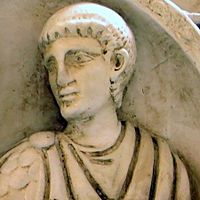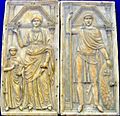Flavius Aetius facts for kids
Quick facts for kids
Flavius Aetius
|
|
|---|---|

Possible relief of Aetius, although the sarcophagus has also been thought to depict Stilicho (d. 408 AD), and can be dated even earlier between 387 - 390 AD, during the reign of Theodosius I
|
|
| Nickname(s) | Last of the Romans |
| Born | c. 391 AD Durostorum |
| Died | September 21, 454 AD Ravenna |
| Buried |
Unknown, Possibly the Stilicho Sarcophagus
|
| Allegiance | Western Roman Empire |
| Service/ |
Roman army |
| Years of service | 405 - 454 |
| Rank | Magister Militum |
| Commands held | Tribunis Partis Militaris Cura Palatii Magister Militum per Gallias Comes et Magister Utriusque Militiae (Junior) Comes et Magister Utriusque Militiae (Senior) Magnificus vir Parens Patriciusque Noster Consul |
| Battles/wars | Siege of Arelate (426) Frankish War of 428 Norican Campaign of 430 Siege of Arelate (431) Frankish War of 432 Battle of Rimini Visigothic War of 436 Burgundian Revolt of 435 Siege of Narbona (436) Sack of Worms (436) Battle of Mons Colubrarius Battle of Vicus Helena Battle of the Catalaunian Plains Invasion of Italy (452) Spanish Campaign of 453 |
Flavius Aetius (born around 391 AD, died 454 AD) was a very important Roman general. He lived during the final years of the Western Roman Empire. For over 20 years, from 433 to 454, he was the most powerful man in the Western Roman Empire.
Aetius was a skilled military leader. He managed the empire's defenses against different groups of "barbarians" (people not from Rome) who were settling within Roman lands. His most famous achievement was gathering a large Roman and allied army. This army stopped the powerful Huns, led by Attila the Hun, in the famous Battle of the Catalaunian Plains in 451 AD. This battle ended the Huns' destructive invasion.
Because of his efforts to protect the Roman Empire, Aetius is often called "the last of the Romans". The famous historian Edward Gibbon described him as "the man universally celebrated as the terror of Barbarians and the support of the Republic."
Contents
Early Life and Rise to Power
Flavius Aetius was born in Durostorum, a city that is now in modern-day Bulgaria. His father was a Roman general, and his mother was from a wealthy Italian family. This background gave him connections and a good start in life.
As a young man, Aetius spent time as a hostage with the Goths and later with the Huns. This might seem strange, but it was a way for different groups to build trust. Living with these groups taught him a lot about their customs and fighting styles. This knowledge would later help him greatly in his military career.
Aetius began his military service around 405 AD. He quickly rose through the ranks. He became a "Magister Militum," which means "Master of Soldiers." This was the highest military rank in the Roman Empire.
Protecting the Western Roman Empire
The Western Roman Empire was facing many challenges during Aetius's time. Different groups, often called "barbarians" by the Romans, were moving into Roman territory. These groups included the Goths, Franks, and Burgundians. Aetius spent much of his career fighting against them or making deals with them.
He fought in many battles and campaigns across Gaul (modern-day France) and other parts of the empire. He won important victories, like the Siege of Arelate (426) and the Sack of Worms (436). These wins helped to keep parts of the empire safe for a while.
Aetius was not just a fighter; he was also a clever politician. He often used diplomacy and alliances to achieve his goals. He even used Hunnic soldiers as allies in some of his campaigns.
The Threat of Attila and the Huns
The biggest threat to the Roman Empire came from the Huns, led by their fearsome leader, Attila. The Huns were a powerful nomadic group from Central Asia. They were known for their fierce cavalry and their ability to conquer vast lands.
In 451 AD, Attila led a massive Hunnic army into Gaul. His goal was to conquer the region and expand his empire. This was a huge danger to the Western Roman Empire. Aetius knew he had to stop Attila.
The Battle of the Catalaunian Plains
Aetius understood that the Roman Empire could not defeat Attila alone. He formed a grand alliance with several groups who were usually enemies of Rome. These included the Visigoths, led by their king Theodoric I, and the Franks.
This combined army met Attila's Hunnic forces at the Battle of the Catalaunian Plains in Gaul. This was one of the largest and most important battles in ancient history. Both sides had huge armies.
The battle was incredibly fierce and bloody. It lasted for a long time, and many soldiers lost their lives, including the Visigothic king Theodoric I. In the end, Aetius and his allies managed to stop Attila's advance. The Huns were forced to retreat, and their invasion of Gaul was ended. This victory saved much of Western Europe from Hunnic rule.
Later Years and Legacy
After the Battle of the Catalaunian Plains, Attila invaded Italy in 452 AD. Aetius again played a key role in defending the empire. He managed to slow Attila's advance and, combined with other factors like disease and diplomacy, Attila eventually turned back.
Aetius remained the most powerful man in the Western Roman Empire. However, his power made the Roman Emperor, Valentinian III, feel threatened. In 454 AD, Emperor Valentinian III personally killed Aetius in the imperial palace in Ravenna. This act was a huge mistake for the empire.
Aetius's death left a massive void in the Western Roman Empire's leadership. He was the last great Roman general who could effectively defend the empire. Without him, the empire quickly declined and fell apart just a few decades later. His legacy is that of a brilliant military leader who fought tirelessly to preserve the Roman way of life against overwhelming odds.
Images for kids
-
The Monza Cathedral Diptych, which may have been commissioned on Aetius' first consulship. It may also depict Stilicho.
See also
 In Spanish: Aecio para niños
In Spanish: Aecio para niños




